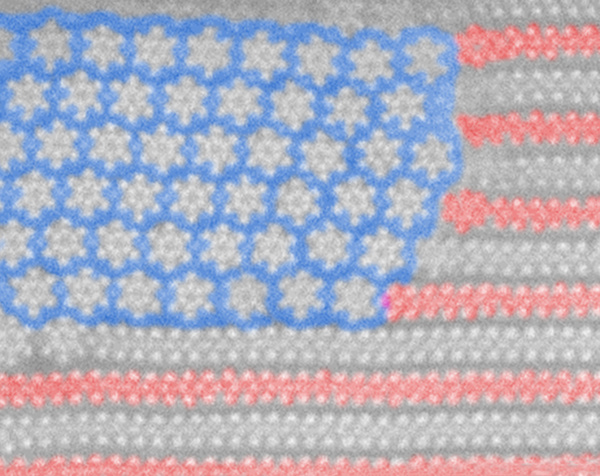|
a team of researchers at that university of texas at dallas made an unexpected breakthrough in their study of materials that could be suitable for powering next-generation electronics. starting with two-dimensional sheets of molybdenum ditelluride, the ut dallas researchers heated the material above 450°c and discovered a phase-change into an array of one-dimensional nanowires that arranged into a pattern similar to the u.s flag.

this microscopic nanoflag pattern emerged as sheets of the “stripe” material were heated to about 450 degrees celsius,
at which point its atoms began to rearrange and form new structures — the “stars” in this false-color image. (ut dallas)
the molybdenum ditelluride, composed of one layer of molybdenum atoms and two layers of tellurium, transitioned to hexa-molybdenum hexa-telluride and in the process formed shapes that looked like repeating rows (or stripes) and tiny six-pointed stars, according to an article on the school’s website.
the team made a false color version and created a “nanoflag” to highlight the phase transition that had not been predicted by theory. the nanowires are semiconductors and the hope is that they can be used as switching devices similar to the way silicon is used to turn electric current on and off in modern devices.
phase transitions can be common, such as water being cooled to form ice, but in some materials these phase changes can have a significant impact on their properties. to better understand how a material is affected by a phase transition, scientists create “phase diagrams,” but before this experiment none had been as patriotic as the ut dallas researchers observed.
“each individual nanowire is a semiconductor, which means that electric current moving through the wire can be switched on and off,” the article explained. “when many of the individual nanowires are grouped together in bulk they behave more like a metal, which easily conducts current.”
the scientists will be examining how to separate individual nanowires and scaling manufacture of the nanowires to an industrial application, but, as one of the researchers noted, “this is a start.”
the research was recently published in advanced materials. the abstract of the report stated:
“a novel phase transition, from multilayered 2h-mote2 to a parallel bundle of sub-nanometer-diameter metallic mo6te6 nanowires (nws) driven by catalyzer-free thermal-activation (400–500 °c) under vacuum, is demonstrated. the nws form along the ?11–20? 2h-mote2crystallographic directions with lengths in the micrometer range.
“the metallic nws can act as an efficient hole injection layer on top of 2h-mote2 due to favorable band-alignment. in particular, an atomically sharp mote2/mo6te6 interface and van der waals gap with the 2h layers are preserved.
“the work highlights an alternative pathway for forming a new transition metal dichalcogenide phase and will enable future exploration of its intrinsic transportation properties.”
|